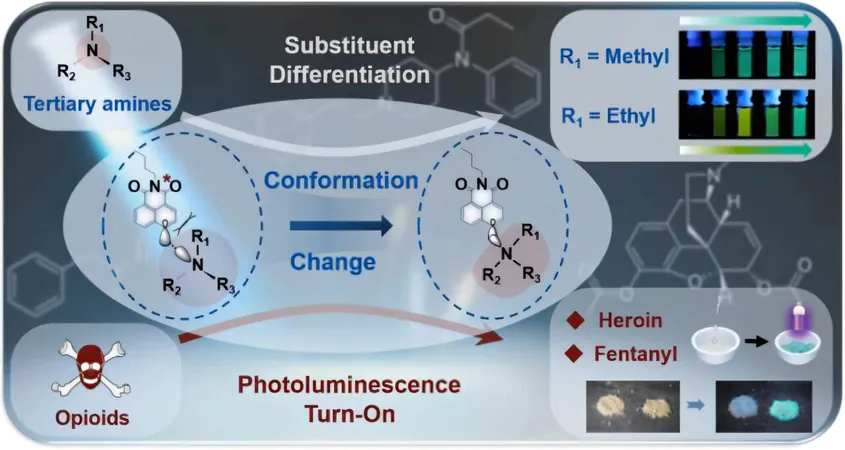
Revolutionary Fluorescence Technique Transforms Detection of Tertiary Amines and Opioids
2025-05-08
Author: Siti
Groundbreaking Research from USTC Unveils Rapid Detection Method
A team of innovative researchers from the University of Science and Technology of China (USTC), led by the visionary Professor Zhang Guoqing, has introduced an impressive new technique that promises to revolutionize the detection of tertiary amines and opioids. Their findings, recently published in the Journal of the American Chemical Society, could have significant implications for various fields—including pharmaceuticals, food safety, and medical diagnostics.
The Challenge of Organic Amine Detection
Understanding organic amines is essential for ensuring safety in pharmaceuticals and food industries, as well as for effective biomedical diagnostics. However, conventional detection methods often suffer from sensitivity and selectivity issues, primarily relying on fluorescence quenching.
A Game-Changer: The Fluorescence Color-Change Strategy
In a striking departure from traditional methods, the USTC team has developed a fluorescence color-change strategy that dramatically enhances detection capabilities. When tertiary amines are exposed to light, they create exciplexes with photoactivated naphthalimide molecules. These then transform into stable photoinduced charge-transfer complexes (PCTCs), allowing the researchers to distinguish between the different structures of tertiary amines based on their unique substituents and molecular flexibility.
Distinct Responses of Tertiary Amines Under UV Light
The researchers explored three categories of tertiary amines—methylated, flexible-chain, and rigid amines—under light exposure with naphthalimide molecules. Their results revealed a fascinating interaction: methylated amines emitted a rapid green fluorescence when illuminated with 365 nm UV light, while flexible-chain amines displayed a sequential color shift from yellow to green. This consistency across 24 different amine samples implies that methyl groups effectively enhance charge transfer by minimizing steric hindrance.
Advancements in Opioid Detection
Leveraging this innovative mechanism, the team has also created a portable visual detection method for both natural and synthetic opioids—including notorious substances like heroin, fentanyl, and methamphetamine. Unlike traditional tests, such as the Marquis reagent, this method is not only faster and simpler but also ideally suited for real-time and on-site monitoring.
Paving the Way for the Future
This groundbreaking work builds upon the researchers' previous discovery of photoinduced charge-transfer complexes, showcasing a crucial enhancement in detection technology. As this technique gains traction, it opens up exciting new avenues for trace amine detection and swift drug screening. The implications are vast, promising safer pharmaceutical practices and more effective public health responses.




 Brasil (PT)
Brasil (PT)
 Canada (EN)
Canada (EN)
 Chile (ES)
Chile (ES)
 Česko (CS)
Česko (CS)
 대한민국 (KO)
대한민국 (KO)
 España (ES)
España (ES)
 France (FR)
France (FR)
 Hong Kong (EN)
Hong Kong (EN)
 Italia (IT)
Italia (IT)
 日本 (JA)
日本 (JA)
 Magyarország (HU)
Magyarország (HU)
 Norge (NO)
Norge (NO)
 Polska (PL)
Polska (PL)
 Schweiz (DE)
Schweiz (DE)
 Singapore (EN)
Singapore (EN)
 Sverige (SV)
Sverige (SV)
 Suomi (FI)
Suomi (FI)
 Türkiye (TR)
Türkiye (TR)
 الإمارات العربية المتحدة (AR)
الإمارات العربية المتحدة (AR)